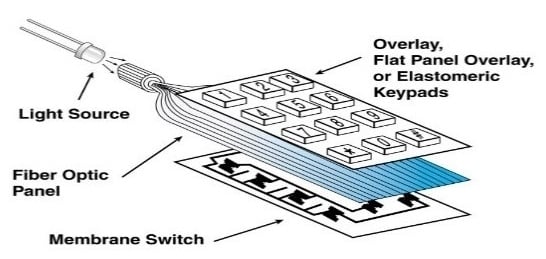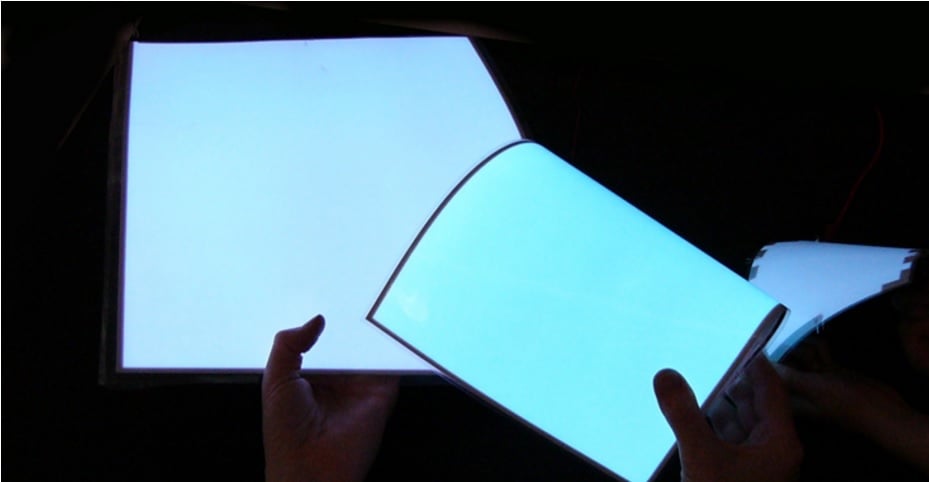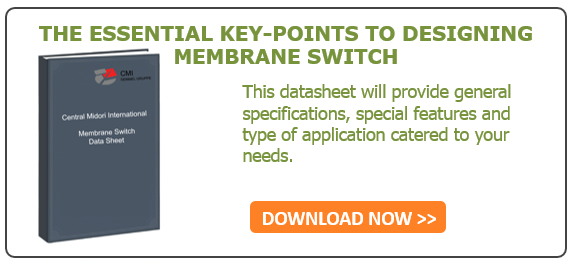Too often, we get frustrated when working in a dark environment with a handheld device / equipment which does not have an illuminated keypad. This forces us to bring along an alternative light source such as a torchlight or mobile phone just to operate in the dark. However, this issue can be easily resolved by having one of several types of illuminated membrane keypad.
There are a few types of backlighting technology that you may want to consider in designing your future keypads. They are namely:
- Discreet LED
- Fiber Optic
- Electroluminescent
- Light guide
1. Discreet LED Backlighting

This technique uses as many LEDs as there are keys. Basically, you need to place the LED close to each icon which you wish to illuminate with a layer of silicone sheet placed over the circuit to diffuse the lighting. However, the uniformity of this type of lighting is poor. Hotspots are created near or over the LEDs. It is suitable only if a small area requires illumination.
Pros
- Set-up cost is low.
- Conventional way to mount LEDs on PCBs and Flexible Printed Circuits (Stable Process).
- Component cost is relatively low.
Cons
- More LEDs needed compared to other backlighting methods.
- The finished part is thick due to the layer of silicone sheet.
- Uniformity is poor.
- Higher power consumption.
- Not suitable for lighting up large areas.
With the visual experience that consumers have become accustomed to via mobile phones, this technology may not be welcome.
2. Fibre Optic Backlighting

Fibre optic backlighting consists of a bundle of optical fibre spread evenly on a panel, ending with a 5mm LED light source. A single LED can illuminate an area of 100 x 250 mm. The design setup cost is low. Not much of engineering works on lighting design needed as compared to the rest, you just need to cut the light panel to the desired shape. Lighting is uniform and the panel is thin and flexible. A single layer panel thickness is about 0.2 mm. A second layer, laminated over the first, may be needed in order to achieve the desired result. It is suitable for low to mid-volume applications.
Pros
- Single LED is required to light up the entire keypad.
- Lighting is uniform throughout the entire area.
- Thin, flexible and bendable to a degree.
Cons
- Higher cost for this Fibre Optics part.
- Low to medium volume applications.
3. Electroluminescent (EL) Technology

An EL lamp is basically a capacitor structure with an EL ink layer sandwiched between two electrodes. With an AC voltage applied across them, this generates a changing electric field within the phosphor particles causing them to emit light. EL lamps can be produced with a screen printing technique. The technology provides a uniform illumination with a thin and flexible panel. It can illuminate a relatively large area compared to other technologies. The setup cost is low and is suitable for low to high volume applications.
Pros
- Uniform illumination throughout the keypad area.
- Set-up cost is low.
- Suitable for low to high volume applications.
- Thin, flexible and bendable illumination option.
Cons
- It needs a DC-AC converter, which typically generates 60-115V AC and 50-1000 Hz.
- Not as bright as the other technologies.
- Cost of EL lamp depends on the brightness, colour and the lifespan of this part.
4. Light Guiding Technology

Light guiding technology simply uses the reflection of light to design the backlighting solution. Light transmitted from LEDs travels in a thin film and is guided to the desired areas of illumination on the overlay. In order to do this, microdots are created on the surface of the areas of illumination. There are a few ways of creating the microdots, these dots can either be etched with tools, laser etched, or even screen printed on thin film. The design of the microdots will determine the brightness of the illumination. It results in a uniformly illuminated, thin, and flexible panel. Uses 60% ~ 70% fewer LEDs when compared to the discrete LED backlighting option. This light guide film can be laid over the metal domes, providing you backlit tactile keypads.
Pros
- Thin and light weight.
- Part price and set-up cost are low.
- Suitable for low to high volume applications.
- Fewer LEDs compared to “Discreet LEDs Backlighting”.
- Flat design.
Cons
- Uniformity of the part is highly dependent on the dot pattern.
- Requires more LEDs should the design have more bends.
- High degree of surface finishing is required for certain light guide materials.
Need advise on backlighting or membrane switches?
Feel free to learn more on designing a membrane switch by downloading the below data sheet.

